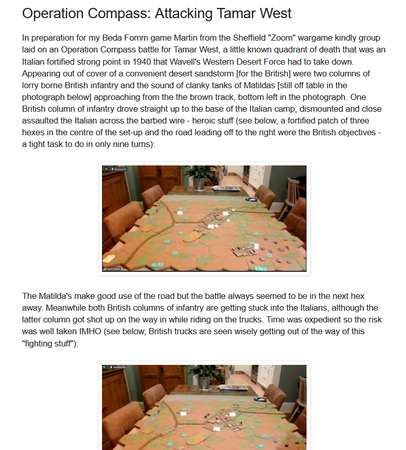
British Army Anti-Tank Units, Western Europe, 1944-1945
64 pages. 8 pages of color profiles, 1 page of color tactical badges and signs. 23 pages of model showcase and kit listing.
This is volume 12 in the TankCraft series. Each book profiles an armored vehicle, and includes a center section with color photos of built-up scale models. The non-color portion of the book is heavily illustrated with photographs.
A 1-page Introduction provides a history of anti-tank units in WWII, leading up to the adoption of self-propelled guns: the Archer, which was delayed in development; the U.S. M10, employed as a stopgap; and the British-modified M10 with the 17-pdr gun, now known as the Achilles (though the nickname was apparently not used during WWII).
…the high casualty rates suffered by the towed anti-tank gun batteries in the Normandy bocage must surely attest to the worth of the self-propelled guns.
– p. 1
The North-West European Battlefield chapter provides maps of France and the Low Countries, numbered to match a guide to major operations of 1944-45. The index lists this chapter as one page, but the following four pages are obviously part of this chapter, providing a timeline of most British operations of 1944-45.
The Anti-Tank Regiments chapter (18 pages) describes all of the regiments, whether equipped with towed guns or self-propelled guns, and whether they served in the field or not. According to the author, it is often difficult to know which anti-tank self-propelled guns a unit had, as the records did not specify. Includes OOBs for Anti-Tank Regiment, Assault Infantry Division, June 1944; Anti-Tank Regiment, Corps Headquarters Troops, July 1944; Anti-Tank Regiment, Armoured Division, July 1944; and Anti-Tank Regiment, Armoured Division, January 1945.
75th Anti-Tank Regiment, RA (TA). Formed in November 1940 from elements of 20th and 59th Anti-Tank Regiments, this unit was attached to 11th Armoured Division from 1941 until the end of the war.
Most of the division was ashore in Normandy by 13 June 1944 and at that time the regiment's 118 and 338 Batteries were each made up of three troops of towed 17pdr anti-tank guns while 117 and 338 Batteries [sic] were equipped with M10 tank destroyers and Achilles 17pdr self-propelled guns (1). From July 1944 M10s were steadily replaced and by December both batteries were made up of three Achilles 17pdr troops receiving, in addition, a number of M22 Locust light tanks for the troop commanders. In the same month the towed batteries were used to form two infantry companies.
In February and March 1945 the regiment took part in Operation Veritable, the battle to clear the Reichswald, and the advance into Germany.
1. I have not been able to determine with any certainty the exact composition of the self-propelled batteries at that time. In any case the M10s were soon replaced.
– p. 53
The Aspects of the British Army chapter (3 pages) explains the relationship between the Royal Regiment of Artillery the Territorial Army, and the Yeomanry. Artillery regiments are explained, as well as markings and camouflage schemes.
The Technical Details and Modifications chapter (4 pages) explains the development of U.S. self-propelled anti-tank guns, provides details of the standard M10, and then explains the modifications introduced for the Achilles variant. Also explained are the various turret counterweights that were used, as well as field modifications to improve armor protection.
The Product Contact List and Acknowledgments chapter (1 page) includes the addresses of kit manufacturers and the author's notes.
The center section, which is almost a book within a book, is in color and breaks down as follows.
Eight pages of color profiles provide 14 side views, 7 front, and 1 rear view, mostly from 1944 but some from 1945. This is followed by one page of unit badges and markings.
Next comes 14 pages of illustrations of built-up scale models. The models showcased depict a 1:35 Achilles of 21st Anti-Tank Regiment, RA, Guards Armoured Division; 1:48 Achilles of 75th Anti-Tank Regiment, RA, 11th Armoured Division; 1:48 M10 of 20th Anti-Tank Regiment, RA, 3rd Infantry Division; 1:48 Achilles of 65 Battery, 6th Anti-Tank Regiment, RCA, II Canadian Corps. Captions explain each modeling project.
The final nine pages of the center section list the companies which produce model kits or conversion parts in 1:35, 1:48, 1:56, 1:72, 1:76 and 1:100 scales, with box, parts, and assembled (unpainted) photos. The author explains that many kits sold as Achilles models are simply M10 kits with the British gun added, but without the other modifications.
I was baffled by the inclusion of some of the material in this book. Five pages chronicling the British army's operations in Europe in 1944-5 seems inappropriate, particularly when anti-tank guns aren't mentioned. I was also at a loss as to why the author listed anti-tank regiments which did not use the M10 or Achilles, or were not deployed to Europe.
Gamers will find this book a useful reference and painting guide. Unfortunately, gamers will need to look elsewhere for scenario inspiration, as there is little here about tactical deployment of the vehicles.
Reviewed by ![]() Editor in Chief Bill
Editor in Chief Bill ![]()
![]() .
.







